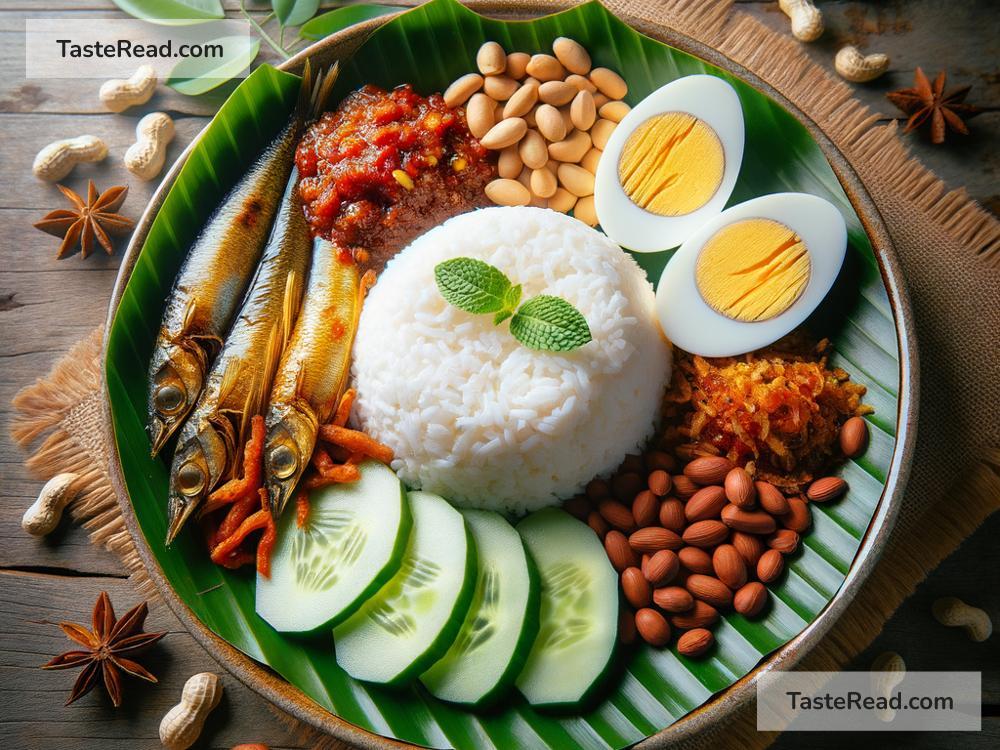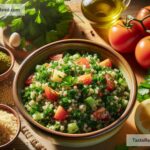Nasi Lemak: The Heart and Soul of Malaysia
Nasi lemak is a dish that holds a special place in the hearts of Malaysians. Known as Malaysia’s national dish, nasi lemak represents the country’s rich cultural diversity and its deep love for flavorful food. This simple yet delicious meal brings people together, showcasing Malaysia’s unique identity both at home and abroad.
What is Nasi Lemak?
Nasi lemak, when translated, means “rich rice.” The name comes from the creamy texture of the rice, which is cooked with coconut milk, also known as “santan.” This fragrant rice is typically served with sambal, a spicy chili paste, crispy fried anchovies (ikan bilis), boiled or fried egg, roasted peanuts, and slices of cucumber. These ingredients are presented on a banana leaf, adding a touch of traditional charm to the dish.
Optional sides can include fried chicken, chicken curry, rendang (slow-cooked meat in spices), cockles, or squid sambal, depending on the vendor or region. Whether you choose the simple version or the deluxe variety, one thing is certain: nasi lemak is a flavorful package that satisfies your taste buds and fills your stomach.
The Origins of Nasi Lemak
Nasi lemak has been a part of Malaysian culture for centuries. It is said to have originated in Malay villages, where farmers and fishermen needed a hearty breakfast that could keep them full throughout the day. The dish evolved out of locally available ingredients like rice, coconut, and chili. Over time, it became a staple not just for breakfast but for lunch, dinner, and even late-night snacks.
Its humble beginnings reflect the resourceful nature of Malaysian people, who made use of simple yet flavorful ingredients to create a dish that would stand the test of time. Today, nasi lemak is enjoyed by people from all walks of life, from roadside stalls to high-end restaurants.
A Dish Representing Unity
One of the most beautiful things about nasi lemak is how it connects people across Malaysia’s diverse cultures. Malaysia is a multicultural country, home to Malay, Chinese, Indian, and other ethnic communities. Each group has its own unique traditions, but nasi lemak is a shared love that everyone embraces.
Cultural variations of nasi lemak can be found across the country. In Malay-style nasi lemak, sambal is often rich and sweet, while Chinese vendors may add sides like fried luncheon meat or curry. Indian-style nasi lemak might feature spicy chicken masala or vegetarian options to cater to dietary preferences. Despite these differences, the essence of nasi lemak remains the same—a dish rooted in simplicity and bursting with flavor.
During large gatherings or festivals, nasi lemak is often served as a communal dish. Sharing this meal reminds Malaysians of the values of harmony and togetherness, making it more than just food; it’s a heartfelt experience.
A Dish That Travels Beyond Borders
Nasi lemak has earned a global reputation as one of Malaysia’s most iconic dishes. Malaysian restaurants around the world proudly feature it on their menus, introducing international diners to its captivating flavors. Tourists visiting Malaysia often try nasi lemak as their first meal, and it’s not long before they fall in love with its unique taste.
The dish has been recognized by food enthusiasts and bloggers from different countries. Some even attempt to recreate nasi lemak in their own kitchens, though capturing the authentic flavor can be a challenge without local ingredients like pandan leaves or sambal belacan (shrimp paste sambal).
Beyond the Plate: Its Symbolic Meaning
Nasi lemak is more than just a food; it’s a cultural icon. It represents Malaysia’s warm hospitality and welcoming spirit. The dish reflects the country’s agricultural roots, where rice and coconut trees are important crops. It also speaks to the Malaysian love for bold and balanced flavors, where spicy sambal complements creamy rice, and crunchy anchovies contrast with fresh cucumber.
For locals, nasi lemak often brings a sense of nostalgia. Many Malaysians remember enjoying it during school recess, roadside breakfasts, or family picnics. The aroma of coconut-infused rice and sambal stirs up fond memories and a sense of home.
Nasi Lemak Today
Today, nasi lemak continues to thrive as Malaysia’s culinary pride. You can find it everywhere—from hawker stalls to hotels, from bustling urban cities to rural villages. Some creative chefs have even reinvented nasi lemak into burgers, sushi rolls, and desserts, proving that this classic dish can evolve while staying true to its roots.
Despite modernization, the traditional way of preparing and enjoying nasi lemak remains loved. Malaysians value authenticity, and many would argue that the best nasi lemak is found at roadside stalls where the recipes have been passed down for generations.
Conclusion
Nasi lemak is not just food—it’s a celebration of Malaysia’s history, culture, and unity. It brings together people from different backgrounds and showcases the country’s love for flavors that excite and comfort. Whether you’re a local or a visitor, nasi lemak is a dish that will leave an everlasting impression.
So, the next time you eat nasi lemak, take a moment to appreciate its significance. It’s a humble dish with a big story, and every bite tells a tale of Malaysia’s rich heritage and proud culinary traditions. Would you like to join the nasi lemak journey? It’s one that truly satisfies both the heart and soul.


